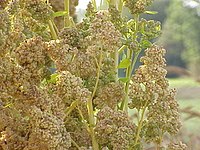
Photo from wikipedia
BackgroundHome gardens are an integral part of many traditional land use systems around the world. They are subject to various conversion processes and undergo a variety of changes. We were… Click to show full abstract
BackgroundHome gardens are an integral part of many traditional land use systems around the world. They are subject to various conversion processes and undergo a variety of changes. We were interested if change is an ongoing process in farmers’ home gardens of Eastern Tyrol (Austria).MethodsIn Sillian, 16 farmers’ home gardens (FHGs) were studied. They had been studied in 1998 and were revisited in 2013 including again a botanical inventory of cultivated and non-cultivated plants, and structured interviews on appearance, management and plant use. In 2017, all the 16 gardens were visited again to verify whether any visible change on spatial configuration had occurred.ResultsThe home garden size had decreased between 1998 and 2013. A wider range of sizes was observed. The occurrence of plant taxa per garden was the same but an increase in the standard deviation of occurrence is seen. Plant diversity (occ./m2) increased between 1998 and 2013. Seventy-nine plant taxa were no longer cultivated in 2013, but 95 new plant taxa were being cultivated. The correlation between garden size and occurrence was not significant, i.e. small gardens might host many different plant taxa or large gardens might have fewer plant taxa. The occurrence for certain use categories was not significantly different between the years, except for the increase in the occurrence of plant taxa used as food and the food subcategory spice. The mean abundance of individuals for all plant taxa showed a significant decrease between the years. In 2013, an increase in standard deviation of abundance is seen. The variation in the different use categories expressed in abundance between the years was not significantly different, except for the decrease in the abundance of plant taxa used as food. Between 1998 and 2017, six home gardens showed a change of their spatial configuration (replacement by raised beds; merging with other structures; conversion to lawn). One FHG shows signs of abandonment.ConclusionsIn Sillian, gardens are by no way static agroecological units, but are dynamic and individual in their appearance, composition and function. Farmers’ home gardens in Sillian show a trend towards becoming more individual, i.e. conversion from being a product of a homogenous local cultural script of the community into an area where gardeners define more individually the role that farmers’ homegardens are expected to play for them or their family.
Journal Title: Journal of Ethnobiology and Ethnomedicine
Year Published: 2018
Link to full text (if available)
Share on Social Media: Sign Up to like & get
recommendations!